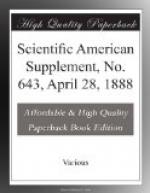Where oil is used it is the very finest olive, produced by the trees in the neighborhood. This is put into copper vats holding about 50 gallons; 1 cwt. of flowers is added. After some hours the flowers are strained out by means of a large tin sieve. The oil is treated with another cwt. of flowers and still another, until sufficiently impregnated. It is then filtered through paper until it becomes quite bright; lastly it is put into tins, and is ready for exportation or for use in the production of extracts.
Where fat is employed as the macerating agent, the fat used is a properly adjusted mixture of lard and suet, both of which have been purified and refined during the winter months, and kept stored away in well closed tins.
One cwt. of the fat is melted in a steam-jacketed pan, and poured into a tinned copper vat capable of holding from 5 to 6 cwt. About 1 cwt. of orange flowers being added, these are well stirred in with a wooden spatula. After standing for a few hours, which time is not sufficient for solidification to take place, the contents are poured into shallow pans and heated to 60 deg. C. The mixture thus rendered more fluid is poured on to a tin sieve; the fat passes through, the flowers remain behind. These naturally retain a large amount of macerating liquor. To save this they are packed into strong canvas bags and subjected to pressure between the plates of a powerful hydraulic press. The fat squeezed out is accompanied by the moisture of the flowers, from which it is separated by skimming. Being returned to the original vat, our macerating medium receives another complement of flowers to rob of their scent, and yet others, until the strength of the pomade desired is reached. The fat is then remelted, decanted, and poured into tins or glass jars.
To make the extrait, the pomade is beaten up with alcohol in a special air tight mixing machine holding some 12 gallons, stirrers moved by steam power agitating the pomade in opposite directions. After some hours’ agitation a creamy liquid is produced, which, after resting, separates, the alcohol now containing the perfume. By passing the alcohol through tubes surrounded by iced water, the greater part of the dissolved fat is removed.
These are the processes applied to the flowers. The leaves are distilled only for the oil of petit grain. This name was given to the oil because it was formerly obtained from miniature orange fruits. From 1,000 kilos. of leaves 2 kilos. of oil are obtained.
The oil obtained from the fruit of the orange, like that of the lemon, is extracted at Grasse by rolling the orange over the pricks of an ecueille, an instrument with a hollow handle, into which the oil flows. The oil is sometimes taken up by a sponge. Where the oil is produced in larger quantities, as at Messina, more elaborate apparatus is employed. A less fragrant oil is obtained by distilling the raspings of the rind.




